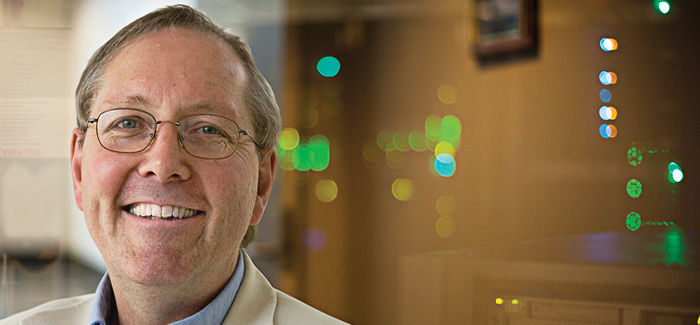
(Photo courtesy Argonne National Laboratory)
Argonne’s new director, Peter B. Littlewood, leads “dream teams” of scientists and engineers working to solve some of society’s most pressing challenges.
Argonne National Laboratory traces its history to a converted squash court underneath the University of Chicago’s abandoned football field. There, on December 2, 1942, a group of 49 scientists led by Enrico Fermi created the world’s first controlled, self-sustained nuclear reaction. From that day to this, the US Department of Energy national laboratories have been charged with addressing this nation’s greatest, most pressing challenges in science and engineering.
At Argonne, we tackle these complex problems by convening multidisciplinary “dream teams” of world-class scientists and engineers, joined by experts from industry, academia, and other national labs. We equip them with some of the most advanced scientific equipment in the world, such as the Advanced Photon Source, which provides brilliant x-ray beams that illuminate and penetrate objects at the nanoscale, and Mira, a powerful supercomputer capable of ten quadrillion calculations per second. Then we challenge these exceptional researchers to identify the heart of the problem, match it to a strategy, and pull together the ideas and resources necessary to build a new and workable solution.
Our results are tremendous. Every one of America’s 104 nuclear power plants has Argonne’s groundbreaking energy research in its DNA. Today Argonne scientists and engineers are still at work on every aspect of nuclear technology, designing power plants that are even safer and more secure and developing new strategies to make sure nuclear materials can be used only for peaceful purposes.
Argonne’s comprehensive energy science research program ranges from the development of game-changing battery systems to the discovery of revolutionary chemical transformation processes for creating new biofuels to the creation of transformational systems for solar energy production. Our battery program includes the new Joint Center for Energy Storage Research (JCESR), where Argonne researchers work elbow to elbow with partners from industry, academia, and our sister labs to build the next generation of battery systems for transportation and the power grid. JCESR’s goals are ambitious and straightforward: we are working to develop a battery that will power an electric car 400 miles on a single charge, and to create grid-level batteries with the capacity to store electricity created by wind and solar farms, so we can use electricity from clean, sustainable sources even when the sun isn’t shining and the wind isn’t blowing.
Argonne’s Center for Transportation Research provides the gold standard for vehicle development and testing. Our research on fuel sprays in combustion engines has changed the efficiency and emissions of today’s cars. Our engineers are fast-tracking the development of tomorrow’s electric vehicles and working with international manufacturers to develop universal standards to make sure those vehicles can plug in and recharge anywhere in the world.
The University of Chicago has managed Argonne since our laboratory’s founding, and our strong collaborative relationship creates opportunities and benefits for researchers at both institutions. Today Argonne is partner in more than a dozen research centers at the University. We are working together to establish the Institute for Molecular Engineering (IME), doing research at the intersection of chemical, electrical, mechanical, and biological engineering and materials, biological, and physical sciences. Researchers at IME are exploring innovative technologies at the molecular scale, seeking novel ways to incorporate synthetic molecular building blocks into functional systems that could solve grand challenges, from advanced medical therapies to quantum computing. Argonne and IME are the initial anchors for the Chicago Innovation Exchange, the University’s new hub for multidisciplinary business start-up activities by University faculty, students, and area entrepreneurs.
These are just a handful of the projects that make Argonne such a fascinating and productive place. Every day, hundreds of the world’s finest researchers come to our campus in Chicago’s western suburbs to tackle the biggest, knottiest, most interesting and important scientific and societal problems—from creating exquisitely sensitive detectors for the giant South Pole Telescope to solving the protein structure that gives the dengue fever virus its deadly power.
Three years ago, I came to Argonne from the Cavendish Laboratory at Cambridge University, drawn by the opportunity to work on the kinds of grand scientific problems that only a laboratory of this scale and caliber can address. Today, as Argonne’s 13th director, I am very proud to have this privilege to lead this laboratory to even greater future achievements, and I remain inspired by its wholehearted dedication to research excellence.
Video
Exploring the role of happenstance and other factors contributing to accidental discoveries, with commentary by Peter B. Littlewood as well as University of Chicago faculty and Argonne and Fermilab scientists, researchers, and engineers.
